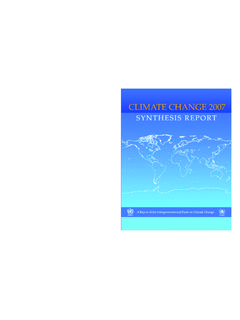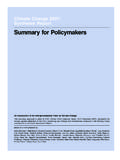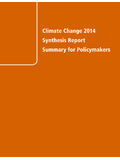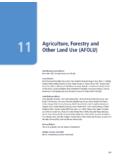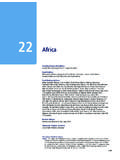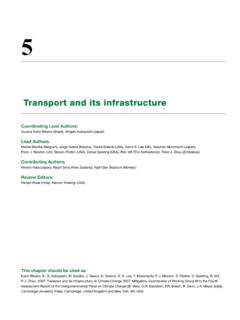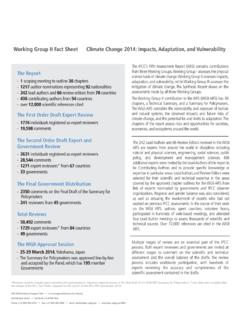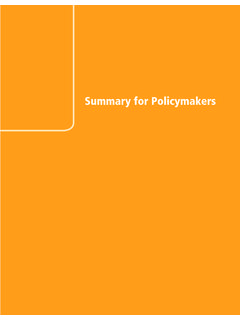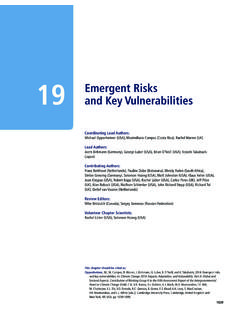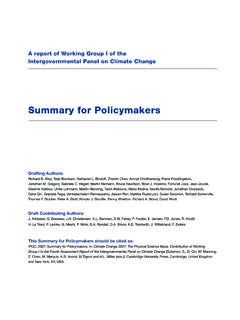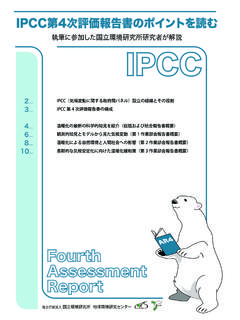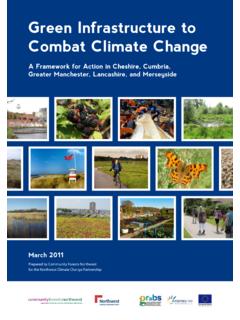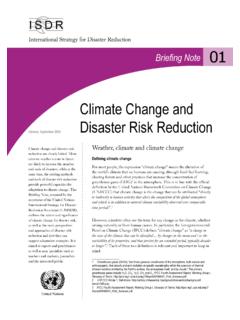Transcription of Climate Change 2014 Synthesis Report - IPCC
1 IntroductionClimate Change 2014 Synthesis ReportIntroduction351 Introduction36 IntroductionIntroduction The Synthesis Report (SYR) of the IPCC Fifth assessment Report (AR5) provides an overview of the state of knowledge concerning the science of Climate Change , emphasizing new results since the publication of the IPCC Fourth assessment Report (AR4) in 2007. The SYR synthe-sizes the main findings of the AR5 based on contributions from Work-ing Group I (The Physical Science Basis), Working Group II (Impacts, Adaptation and Vulnerability) and Working Group III (Mitigation of Climate Change ), plus two additional IPCC reports (Special Report on Renewable Energy Sources and Climate Change Mitigation and Spe-cial Report on Managing the Risks of Extreme Events and Disasters to Advance Climate Change Adaptation).
2 The AR5 SYR longer Report is divided into four topics. Topic 1 (Observed Changes and their Causes) focuses on observational evidence for a changing Climate , the impacts caused by this Change and the human contributions to it. Topic 2 (Future Climate Changes, Risks and Impacts) assesses projections of future Climate Change and the resultant pro-jected impacts and risks. Topic 3 (Future Pathways for Adaptation, Miti-gation and Sustainable Development) considers adaptation and miti-gation as complementary strategies for reducing and managing the risks of Climate Change . Topic 4 (Adaptation and Mitigation) describes individual adaptation and mitigation options and policy approaches.
3 It also addresses integrated responses that link mitigation and adapta-tion with other societal challenges of understanding and managing risks and uncertainties are important themes in this Report . See Box 1 (Risk and the Manage-ment of an Uncertain Future) and Box 2 (Communicating the Degree of Certainty in assessment Findings). This Report includes information relevant to Article 2 of the United Nations Framework Convention on Climate Change (UNFCCC). Box | Risk and the Management of an Uncertain FutureClimate Change exposes people, societies, economic sectors and ecosystems to risk. Risk is the potential for consequences when some-thing of value is at stake and the outcome is uncertain, recognizing the diversity of values.
4 {WGII SPM Background Box , WGIII , SYR Glossary}Risks from Climate Change impacts arise from the interaction between hazard (triggered by an event or trend related to Climate Change ), vulnerability (susceptibility to harm) and exposure (people, assets or ecosystems at risk). Hazards include processes that range from brief events, such as severe storms, to slow trends, such as multi-decade droughts or multi-century sea level rise. Vulnerability and exposure are both sensitive to a wide range of social and economic processes, with possible increases or decreases depending on development pathways. Risks and co-benefits also arise from policies that aim to mitigate Climate Change or to adapt to it.
5 ( )Risk is often represented as the probability of occurrence of hazardous events or trends multiplied by the magnitude of the conse-quences if these events occur. Therefore, high risk can result not only from high probability outcomes but also from low probability out-comes with very severe consequences. This makes it important to assess the full range of possible outcomes, from low probability tail outcomes to very likely outcomes. For example, it is unlikely that global mean sea level will rise by more than one meter in this century, but the consequence of a greater rise could be so severe that this possibility becomes a significant part of risk assessment .
6 Similarly, low confidence but high consequence outcomes are also policy relevant; for instance the possibility that the response of Amazon forest could substantially amplify Climate Change merits consideration despite our currently imperfect ability to project the outcome. ( , Table ) {WGI Table , WGII SPM A-3, , Box 4-3, WGIII Box 3-9, SYR Glossary}Risk can be understood either qualitatively or quantitatively. It can be reduced and managed using a wide range of formal or informal tools and approaches that are often iterative. Useful approaches for managing risk do not necessarily require that risk levels can be accurately quantified.
7 Approaches recognizing diverse qualitative values, goals and priorities, based on ethical, psychological, cultural or social factors, could increase the effectiveness of risk management. {WGII , , , , WGIII , , }Introduction37 Introduction Box | Communicating the Degree of Certainty in assessment FindingsAn integral feature of IPCC reports is the communication of the strength of and uncertainties in scientific understanding underlying assessment findings. Uncertainty can result from a wide range of sources. Uncertainties in the past and present are the result of limita-tions of available measurements, especially for rare events, and the challenges of evaluating causation in complex or multi-component processes that can span physical, biological and human systems.
8 For the future, Climate Change involves changing likelihoods of diverse outcomes. Many processes and mechanisms are well understood, but others are not. Complex interactions among multiple climatic and non-climatic influences changing over time lead to persistent uncertainties, which in turn lead to the possibility of surprises. Compared to past IPCC reports, the AR5 assesses a substantially larger knowledge base of scientific, technical and socio-economic literature. {WGI , WGII SPM A-3, , WGIII }The IPCC Guidance Note on Uncertainty a defines a common approach to evaluating and communicating the degree of certainty in findings of the assessment process.
9 Each finding is grounded in an evaluation of underlying evidence and agreement. In many cases, a Synthesis of evidence and agreement supports an assignment of confidence, especially for findings with stronger agreement and mul-tiple independent lines of evidence. The degree of certainty in each key finding of the assessment is based on the type, amount, quality and consistency of evidence ( , data, mechanistic understanding, theory, models, expert judgment) and the degree of agreement. The summary terms for evidence are: limited, medium or robust. For agreement, they are low, medium or high. Levels of confidence include five qualifiers: very low, low, medium, high and very high, and are typeset in italics, , medium confidence.
10 The likelihood, or probability, of some well-defined outcome having occurred or occurring in the future can be described quantitatively through the follo-wing terms: virtually certain, 99 100% probability; extremely likely, 95 100%; very likely, 90 100%; likely, 66 100%; more likely than not, >50 100%; about as likely as not, 33 66%; unlikely, 0 33%; very unlikely, 0 10%; extremely unlikely, 0 5%; and exceptionally unlikely, 0 1%. Additional terms (extremely likely, 95 100%; more likely than not, >50 100%; more unlikely than likely, 0 <50%; and extremely unlikely, 0 5%) may also be used when appropriate. Assessed likelihood is typeset in italics, , very likely.
